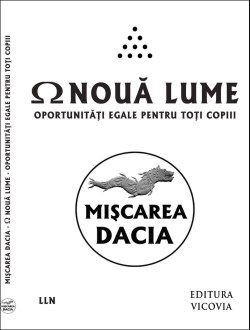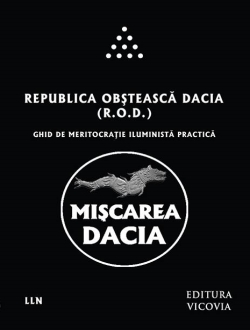 Vă invit să vă alăturaţi grupului Facebook Mişcarea DACIA, ce-şi propune un alt fel de a face politică!
Vă invit să vă alăturaţi grupului Facebook Mişcarea DACIA, ce-şi propune un alt fel de a face politică!Citiţi partea introductivă şi proiectul de Program, iar dacă vă place, veniţi cu noi !
O puteţi face clicând alături imaginea, sau acest link
Posts Tagged ‘Descartes’
Hyperian History Of The World (18th Century, Part 2)
Hyperian History Of The World (18th Century, Part 2)
Philosophically speaking, 17th century rationalism had flourished in continental Europe, beginning with Descartes and culminating with Leibniz going into the 18th century. In parallel to this course, there had also been a strain of philosophy running in Britain which opposed rationalism. This was empiricism.
If the continental rationalists followed the example of Plato, then the British empiricists followed the example of Aristotle. Beginning with Francis Bacon, the empiricists were ‘outward’ looking philosophers, much more like scientists, who looked out into the physical world around them and sought to explain it based solely on their experiences of it.
Towards the end of the 17th Century, it was John Locke who, disregarding rationalism completely, said that humans can only have knowledge that is ‘a posteriori’ i.e. based upon experience. He described the human mind as a ‘tabula rasa’, a blank slate completely empty at our birth but then becoming populated with ideas based only on the experiences we have of the world.
Locke’s empiricism was materialist, philosophically accompanying the empiricist, materialist science of Newton. Going into the 18th century, Irish philosopher and Anglican bishop George Berkeley feared that Locke’s philosophy would lead to atheism and so proposed an alternative version of empiricism which was idealist rather than materialist. According to Berkeley, matter only exists when it is being perceived by an observer. Without observation there is no matter at all. So what stops the room ceasing to exist when we exit it? Conveniently, Berkeley said that god was constantly observing everything in the universe, thereby stopping things from ceasing to exist when we stop observing.
But the most extreme empiricist of the 18th century was Scottish philosopher David Hume. With Hume empiricism descends into absolute skepticism. Given that, according to Hume, all our knowledge derives from our experiences, from what we observe, it becomes impossible to provide any rational explanation of anything, as reason supposes causation and, as Hume insists, causation cannot be observed, therefore we can never really be certain of anything. Hume’s philosophy leads towards complete uncertainty about anything whatsoever.
Of course, another way of looking at Hume’s philosophy is to say that it proves that empiricism is clearly a false ideology which will never provide any certain knowledge about the universe. Unfortunately, Hume did not see it this way, concluding rather that no philosophy could provide any certain knowledge about the universe, as he had presupposed that empiricism was the only relevant philosophy.
Hume’s philosophy was the culmination of British empiricism the way that Leibniz’s was the culmination of continental rationalism. However, the next great continental philosopher, the German Immanuel Kant, was far more influenced by Hume than by Leibniz. Inspired by a desire to resolve Hume’s skeptical conclusions, Kant attempted to sculpt a grand system which would synthesise the two parallel strains of philosophy.
Whereas Descartes divided everything into mind and matter, Kant divided everything into the phenomenal and the noumenal. The phenomenal realm corresponded to the physical realm of matter, the realm that we experience with our senses, that we can see, hear, touch and feel. The noumenal realm corresponded to realm of mind, like Plato’s realm of the perfect Forms, the true realm of things as they really are in themselves. However, in line with empiricism, Kant suggested that we can only ever experience the phenomenal realm and never experience the noumenal realm, as our minds only interpret the noumenal realm and it is this interpretation that creates the phenomenal realm that we experience.
Kant had far more rigorously defined all of these issues philosophically but had still reached the conclusion that we can never know how the universe actually is. This was due to his ignoring of the mathematical side of things. Kant’s attempt was valiant, yet he ought to have ignored British empiricism and focused on Leibniz’s rationalism and its need for mathematical rigour. Ingenious though his philosophy was, Kant’s failure to apply mathematics to it is what resulted in his conclusion that we can never truly know the universe.
Nonetheless, Kant became one of the most influential philosophers of the modern age and his ideas, along with those of the British empiricists, would influence the science which had begun with Newton. As such, science became completely based on empiricism and materialism, Newton was a hero, as were Kant and Hume, with Descartes and Spinoza being reduced to academic curiosities and Leibniz all but forgotten.
Nonetheless, this age of enlightenment was clearly an improvement on the preceding dark age of christian domination. Despite ignoring the wisdom of the great rationalists, the world of the 18th century seemed to be brightening and great wonders were still to come, both artistically and politically.
What Constitutes Existence?

What Constitutes Existence?
Many philosophers and religious thinkers have proposed endless ways to describe the basic nature of existence. So, let’s play the God Game. If you were God, which of the following options would you have chosen? We shall take an incredible tour of the multitude of options available to God.
Materialism: “The world … is corporeal, that is to say, body … and every part of the universe is body, and that which is not body is no part of the universe.” – Thomas Hobbes
Idealism: Everything is mental; the material world is ultimately mental.
Panpsychism: all matter has a mental aspect; mind is everywhere; all entities have a unified centre of experience; all entities have their own unique point of view (perspective); all parts of matter involve mind, or more holistically, the whole universe is an organism that possesses a mind; the idea that all matter is imbued with some (greater or lesser) form of consciousness.
The distinction between idealism and panpsychism is that the latter treats everything as mind or as containing mind whereas the former treats things as content of the mind. In panpsychism, a rock, for example, has a mind (albeit rudimentary and unconscious) whereas in idealism, a rock has no independent material existence but is merely a mental phenomenon – an idea in a mind. In panpsychism, a rock doesn’t vanish if the mind perceiving it dies. In idealism, the rock is dependent in the mind’s perception of it, so “dies” when the mind dies. In other words, panpsychism allows for the objective existence of things whereas idealism is purely subjective (all apparently objective things are contained within subjective minds, and do not exist without the subjective minds that sustain them).
Illuminism agrees with idealism that mind and not matter is the basis of reality, but Illuminism is fundamentally an expression of panpsychism. “Panpsychism is the view that the basic physical constituents of the universe have mental properties” — Thomas Nagel
Dualism: the view that mind and matter have independent existence and neither is reliant on the other or originates from the other.
Panpsychism is sometimes seen as dualist since it attributes mind to matter, thus acknowledging the objective existence of matter, and regards everything as having both mental and physical properties. In Illuminism, mind and matter are both mathematical and matter is in some sense “solid” mind i.e. matter is an expression of mind. It has different mathematical characteristics: above all the number zero is excluded from material existence yet defines mental existence.
“In the matter of consciousness, the position of Empedocles may be defined as a rigorous panpsychism. In his view, which seems to be shared to some degree by most early Greek thinkers, the faculty of feeling, perception, and thought does not constitute a prerogative of men and animals, but is assumed to be distributed generally throughout the natural world. From this point of view, there is really no such thing as inanimate nature. The character of any object is conceived of as a vital urge that may be described in terms of thought and volition. This conception is analogous to the ‘animism’ which is said to characterise the attitude of many primitive peoples in their dealings with nature. But the animism of Empedocles is scarcely primitive: it is explicitly formulated as a philosophic principle. He ends the poem On Nature with a warning to his friend Pausanias that the truths communicated must be carefully borne in mind, or else they will leave you all at once, when their times come round, yearning after their fellows, to return to their own dear kind; for know that all things have intelligence and a share in thought. This statement implies a systematic parallelism between physical objects and mental conceptions. Not only does everything have a share in thought, but every thought is treated like a thing. Apparently Empedocles recognizes no radical distinction between the two, for the constituents of the physical world and our perception of this world are described in the same terms:
By earth we behold earth, by water water,
by air bright air, by fire, ravaging fire,
love by love and strife by gloomy strife.
For out of these are all things compounded
and fitted together and with these do they think
and feel pleasure and pain.”
— Essays in Ancient Greek Philosophy, Edited by John P. Anton with George L. Kustas
Reductive panpsychism reduces all material properties to mind.
Reductive physicalism does the opposite and reduces everything to matter.
Reductive physicalism is essentially materialism: everything in the world can be reduced analytically to its fundamental physical, or material, basis. All mental states and processes can be reduced to physical states and processes. All organic and inorganic processes can be explained by reference to the laws of physical nature.
Illuminism, on the other hand, reduces everything, mental and material, to mathematics and asserts that all organic and inorganic processes can be explained with regard to mathematical laws of existence.
Neutral monism: this is the view that the mental and the material are two different perspectives of the same underlying thing, which is itself “neutral” i.e. neither physical nor mental. So, this stance rejects the view that the mental and the physical are two fundamentally different things and asserts that there is only one fundamental “stuff” in the universe (hence why it’s a monism). Neutral monism was first propounded by Spinoza who proposed that mind and matter were two attributes of God (the underlying monism), although Spinoza’s view might better be called dual-aspect monism:
“In strict parlance, neutral monism should be distinguished from dual-aspect monism, which holds that all existence consists of one kind (hence monism) of primal substance, which in itself is neither mental nor physical, but is capable of distinct mental and physical aspects or attributes that are two faces of the same underlying reality in the one substance. … The theory’s relationship to neutral monism is ill-defined, but one proffered distinction says that whereas neutral monism allows the context of a given group of neutral elements to determine whether the group is mental, physical, both, or neither, double-aspect theory requires the mental and the physical to be inseparable and irreducible (though distinct).” — Wikipedia
Schopenhauer, like Spinoza, is a dual-aspect monist. In Schopenhauer’s philosophy, there is only one substance (Will), but it manifests itself physically (phenomenally) and mentally (noumenally), with each being the flip side of the other.
Illuminism might be considered a dual-aspect monism. Mathematics is the ground of existence (the monism) and takes the form of infinite mathematical points, inbuilt with the laws of mathematics. Since a monad is a rudimentary mind, mind and mathematics are intimately connected. Mind can be considered as subjective mathematics – how it feels to be a mathematical entity; the inside perspective; the inner experience – while matter is objective mathematics, subject to the laws of what humanity calls science. Subjective mathematics is the within of mathematics while objective mathematics is the without.
It is a primary axiom of Illuminism that all of the fundamental units of existence are subjective when experienced internally and objective when viewed externally. Everything is a subject to itself, but an object to everything else. If a subject acquires a body (as in a human being) then that constitutes its objective presence in the world, while the mind is its subjective presence.
William James also developed a neutral monist view, and is perhaps the classic expression of that view. Bertrand Russell said, “James’s view is that the raw material out of which the world is built up is not of two sorts, one matter and the other mind, but that it is arranged in different patterns by its inter-relations, and that some arrangements may be called mental, while others may be called physical.”
Panpsychism can be readily combined with neutral monism. Illuminism is the stance that mathematics is the basis of mind and matter, hence mathematics is the neutral monism in that sense. Each mathematical point is regarded both as a unique mind and as fundamental building block of the material world. (Many of these definitions flow in and out of each other or form a continuum rather than clear-cut distinctions.)
Holism: the view that the whole Universe is an organism that possesses a mind. Equivalent to a certain view of panpsychism.
Animism (from Latin anima “soul, life, mind, breath”; similar in concept to Greek words such as psyche and pneuma): the view that all things have a soul; all animate and inanimate objects possess individual, innate souls; the hypothesis first advanced by Pythagoras and later promoted by Plato that an immaterial force animates the universe (the World Soul).
Animism is the belief that non-human entities are spiritual beings, or embody a life-principle. In this view, there is no separation between the spiritual and physical worlds. Souls/spirits exist not just in humans, but also in all other animals, plants, rocks, and all natural phenomena. Thunder and lightning have souls. Mountains, rivers, woods, stars, planets, galaxies, black holes – they all have souls. The universe is a vast network of ensouled creatures. Personalized supernatural beings (or souls) occupy all objects and govern their existence. Just as a human body is said to have a soul, all bodies of any type at all (including inorganic bodies) also have souls, although of very different mental character. Animism is the view that spirits inhabit the universe in all of its parts.
Extreme animism attributes souls even to abstractions such as words, true names (which have tremendous power in the occult world), and mythological symbols. Shinto, Hinduism, Buddhism, Taoism, Pantheism and Neopaganism all have significant animistic tendencies.
Illuminism is a type of animism since it teaches that living (but unconscious) monads are the source of everything in the world. However, while animism assigns consciousness to all things, Illuminism does not. Illuminism is about the unconscious mind evolving towards consciousness as its highest manifestation.
In Illuminism, unconscious monads are the building blocks of existence. Existence is predicated on fundamental units of mathematical life. Ontological mathematics is alive. All mathematical functions and signals produce an inner experience in the living monads affected by them.
Animism was the first religious system conceived by the human mind and, when equated with ontological mathematics, becomes supremely powerful. However, when associated with primitive beliefs and superstitions, it degenerates into the monotheistic Abrahamic system that there is one single and all-unifying animating force in the universe – God, the Creator.
Abrahamism is animism taken to its extreme position in terms of conscious design of the universe. Illuminism is animism taken to its extreme position in terms of unconscious, teleological evolution of the universe.
Science disregards animism completely, and is thereby incapable of explaining how life comes from non-life. It should be noted that life/non-life dualism is just another way of talking about the mind-body problem. Life and mind are effectively synonymous. You are alive if you have a mind, even if that mind is rudimentary and unconscious.
Illuminism solves mind-body dualism by demonstrating that the body originates in mind (i.e. there is no separate material world). It solves the life/non-life problem by demonstrating that everything is alive (i.e. there’s no kingdom of dead things that are somehow assembled like Frankenstein’s monster into living beings). Existence MUST be monistic. There can be no existential dualism.
Science claims to be a monistic materialism, but philosophically it is radically dualistic since it cannot offer any viable mechanism to account for how mind comes from non-mind or life from non-life. Although science claims that life and mind are materialistic phenomena that originate in more elemental materialistic phenomena, in reality the gulf between mind and non-mind and life and non-life is infinite.
Descartes’ philosophy failed because of its dualism. Either matter must be fully explained by mind, or mind by matter. Illuminism is the proof that matter is ultimately mental and not physical. Science, on the other hand, has wholly failed to prove that mind is ultimately material.
Excerpt from The God Game
Mike Hockney
Artwork by Yuliya Zelinskaya
Tags: Animism, Descartes, Dualism, Holism, Idealism, Illuminism, Materialism, Monism, Panpsychism, Physicalism, Science
As Above, So Below
Tags: As Above, Brain, Consciousness, Descartes, Dream, Illuminati, Mater, Mind, So Below, Sound, UnConsciousness, Vibration, Wavw
Mathematicos (6)
Cuvinte și Numere
„Adevărul refuză cuvintele create de om pentru a-l descrie. Rezultatul Cuvintelor este Mytos… Credință, Opinie, Interpretare… concepte omenești ale Realității.
Antidotul este Logos. Dacă Mythos este Cuvântul, Logosul este Numarul. Ne apropiem cu atât mai mult de Adevăr, cu atât mai mult cu cât folosim Numerele Ontologice pentru a-l descrie. Singularitățile zero / infinit nu pot fi ignorate în niciun sistem Logos.
Textele Religioase sunt false deoarece nu folosesc Matematica (Numerele). Știința e poziţionată mai bine decât Religia pentru că o face, dar o face incomplet, nefolosind TOATE Numerele, alunecând în filosofia greșită (Mythos) a Empirismului și Materialismului.
Matematica Abstractă este inferioară Matematicii Ontologice deoarece, ca şi Ştiința, nu reușește să definească și să utilizeze corect Numerele.
„Lucrarea lui Descartes a fost punctul culminant al unui proces de eliberare a Algebrei de Cuvinte, după cum Geometria greacă a eliberat Construcțiile de Numere. Odată ce a oferit un formalism pentru descrierea relațiilor algebrice, progresul a fost rapid. După patruzeci de ani de la publicarea Geometriei Algebrice a lui Descartes, filosoful german și matematicianul Gottfried Wilhelm von Leibniz (1646-1716) a creat o Algebră a Infinitului. Aceasta este ceea ce numim „Calculul”, un instrument puternic pentru analiza Creșterii și a Schimbării.
Isaac Newton (1642-1727) a făcut o descoperire echivalentă mai înainte, dar el a extins doar notația lui Descartes, mai degrabă decât să-l depășească, așa că este forma leibniziană de Calcul, cea care predomină astăzi. Astfel, au fost doi filozofi, Descartes și Leibniz [Mike Hockney: Idealist-Rationalişti!], care au creat Notaţiile și Ideile care au format Matematica de atunci. … Procesul de a găsi cât de repede se schimbă Cantitatea se numește Diferențiere. Când Diferenţiem o funcție, obținem rata de Schimbare a acesteia. “– Ziauddin Sardar și Jerry Ravetz”
Mintea și Corpul
Cum se relaţionează Mințile la Corpuri? Dacă Mințile controlează cu adevărat Corpurile (cum se pare că fac), cum se explică? Răspunsul este Transformarea Fourier care permite funcțiilor matematice dintr-un Domeniu de Frecvență în afara Spațiului și Timpului (un domeniu mental) să fie reprezentate ca funcții materiale în spațiu și timp (un domeniu fizic).
Materialismul Ştiințific nu poate ajunge la această concluzie matematică simplă, deoarece neagă existența unui domeniu mental neobservabil, fără dimensiuni, în afara spațiului și timpului.
Transformarea Fourier stă la baza Mecanicii Cuantice și Holografiei. Mai mult sau mai puțin, toate problemele științei ar dispărea dacă oamenii de știință ar accepta realitatea ontologică a Transformărilor Fourier care unește două Domenii Matematice: unul în spațiu și timp (Materie – Corp) și altul în afara spațiului și timpului (Mintea).
Transformarea Fourier este exemplul arhetipal al locului în care matematica se ciocnește cu metoda experimentală a științei, care Ştiință alege să susțină Experimentele în locul Matematicii. Dacă ar inversa această politică, știința ar deveni matematică și toate absurditățile Empirismului ar fi depășite.
Știința este îngrozită de faptul că Realitatea este împărțită în două categorii radical diferite (mintea neobservabilă și materia observabilă), deoarece metoda științifică se adresează numai uneia dintre ele (materie observabilă). Totuși, Transformarea Fourier este un instrument matematic fundamental care demonstrează că nu puteți avea o Realitate care nu se împarte în două domenii inter-conexe, transformabile.
Știința nu a reușit niciodată să înțeleagă ce înseamnă cu adevărat Transformarea Fourier. Dacă s-ar întâmpla, ar vedea că nu are altă posibilitate decât să accepte Ontologia Dualistă (de fapt Monismul cu dublu aspect) asociată cu Transformarea Fourier – un domeniu observabil (al materiei) și un domeniu neobservabil (mintea), care dă naștere acesteia (materia).
Știința spune că nu există Minți, ci doar Materie, care dă naștere la Minte. Leibniz a spus că există infinite minți matematice care dau naștere la fenomenul materiei. El ar fi invocat Transformarea Fourier pentru a-și explica sistemul, dacă ar fi fost cunoscut în zilele lui. Pentru Leibniz, nu există Substanțe Materiale, doar Fenomene Materiale care derivă din Minţile Matematice (adevăratele Substanțe ale Existenței).
Adevărul
„Ființele umane, prin schimbarea Atitudinilor Interioare ale Minții lor, pot schimba Aspectele Exterioare ale vieții lor” – William James
Lucrul pe care trebuie să-l schimbați mai presus de toate este atitudinea voastră față de Adevăr. Trebuie să vă întrebați ce fel de caracter trebuie să aibă Adevărul și cum putem avea acces la el. Avem oare acces la Adevărul etern prin Sentimentele, Simțurile, Intuițiile noastre, sau prin Rațiunea noastră? Dacă Adevărul nu se referă la Sentimente, este inutil să vă aduceți Sentimentele la căutarea Adevărului. Același lucru este valabil și pentru Simțuri.
Este Adevărul în „Conștiența Golită” (prin Meditaţie în religiile orientale)? Ce inseamnă asta? „Conștienţa Golită” se referă la o stare ipotetică, empirică a Minții. Are o legătură exact Zero cu Adevărul etern, necesar, cognoscibil și inteligibil.
Când îl caută, oamenii caută de regulă altceva decât Adevărul. Ei vor ca lucrurile să le hrănească Simțurile, Sentimentele și Intuițiile și nu au decât dispreț pentru Rațiune (Martin Luther – „Raţiunea e o curvă a Diavolului”). Cu toate acestea, numai Raţiunea este despre Adevărul etern, necesar. 1 + 1 = 2 este cea mai Adevărată declarație pe care ați făcut-o vreodată. Este Adevărat dintotdeauna, chiar şi dinainte de apariţia Omului în Univers, spre deosebire de toate Sentimentele, Senzațiile, Ipotezele, Credințele, Opiniile, Experiențele, Interpretările și Intuițiile Mistice.
„Nu putem niciodată să știm totul. … Nu poți ajunge până la sfârșitul Înțelegerii, dar puteți înțelege întotdeauna mai mult. “- Tara Shears
Din contră, cu siguranță putem cunoaște toate lucrurile și înțelege totul… Matematic.
Numai Matematica poate fi înțeleasă pe deplin și definitiv și, dacă Realitatea este matematică (așa cum este și cum trebuie să fie), atunci Realitatea însăși poate fi înțeleasă pe deplin și definitiv.”
Tags: Adevăr, Corp, Credinţa, Descartes, Frecvenţe, Leibniz, Matematica Ontologică, Minte, Monism, Mytos, Newton, Numere, Religie, Singularitate, Transformate Fourier
ReLigare (8)
Îngerii sunt reali
„Datorită scepticismului științific, Îngerii sunt de obicei considerați o absurditate, însă mulți dintre cei mai mari intelectuali ai lumii, cum ar fi Socrates, Platon, Plotinus, Sf. Augustin, Bonaventure, Thomas Aquinas, Descartes și Leibniz, au acceptat existența lor. Acești gânditori iluştri erau mult mai inteligenți decât oamenii de știință tipici, și trebuie spus că știința nu a demonstrat niciodată inexistența Îngerilor şi cu atât mai mult, a Minţii. De fapt, Îngerii sunt creaturile arhetipale ale Minții, deoarece sunt fără corpuri materiale. Sunt intelecturi pure și posedă o Cunoaștere uluitoare, divină. Atunci când au nevoie temporar de un organism pentru a interacționa cu oamenii, ei își pot valorifica puterea și cunoștințele intelectuale pentru a produce unul, din atomii din aer.
Existența Îngerilor este dovedită de Matematică. Îngerii nu sunt mai misterioși sau mai incredibili decât numerele „imaginare” și „complexe”, monadele leibniziene (singularități) sau fotonii fără masă, fără dimensiuni, sau zero și infinit. O mare parte din cele susţinute de oamenii de știință cu privire la Mecanica Cuantică sunt de un ordin mult mai ridicat de improbabilitate, ilogică și absurditate decât orice s-ar fi spus despre Îngerii. De fapt, știința ar face bine să studieze Matematica „Îngerilor” -Ontologică- dacă dorește să spună lucruri sănătoase, raționale despre Mecanica Cuantică.
Oamenii aparțin Ordinii Dimensionale a Existenței, iar Îngerii aparțin Ordinului Fără Dimensiuni.
Știința, bazată pe Materialism, Empirism și Dimensionalitate, nu poate spune literalmente nimic despre existența fără dimensiuni, dar există un subiect suprem pentru știință care poate face totul atât de ușor… Matematica.
Plotinus a spus: „Omenirea se găsește la jumătatea distanței dintre zei și fiare”.
Ce suntem noi – animale mai evoluate sau îngeri căzuți? … sau suntem noi Înger în Maimuţă?”

Tags: Adimensional, Corp, Descartes, Dimensional, Îngeri, Intelect, Leibniz, maimuţă, Matematică, Mecanica Cuantică, Minte, Platon, Plotinus, Sf. Augustin, Socrate














